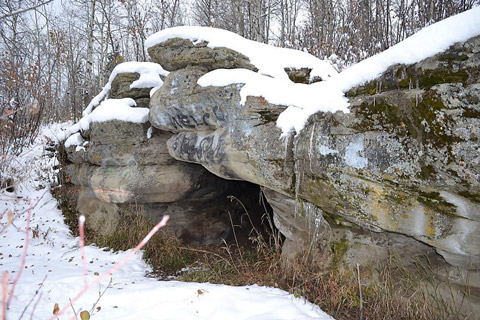Tse'K'wa National Historic Site

© M. Stopp, Parks Canada.
Tse’k’wa is an exceptional archaeological site in northeastern British Columbia that has contributed to the understanding of environmental changes and human settlement from the end of the last glacial period (12,500 years ago) to 1,000 years ago. Also known as Charlie Lake Cave, it features a sequence of radiocarbon dated and relatively undisturbed soil layers that is rare in North America. The site is important for what it has revealed about the earliest humans and their movement over time, their way of life, about the cultures that followed, and about post-glacial environmental change.
Tse’K’wa lies in the rolling terrain of the Peace River District to the east of the Rocky Mountains, nine kilometres northwest of Fort St. John. The site is within the traditional territory of the Dane-zaa First Nations, and for these First Nations groups, who are stewards of this site, it is a spiritual place and a touchstone to their lengthy presence in the Peace River region, to nearby Charlie Lake, and to the site itself. The site has become an integral element of Dane-zaa identity and continuing traditions maintained through oral histories, stories, and songs.
The lowermost soil layers at Tse’K’wa held a combination of undisturbed evidence of Canada’s earliest inhabitants, known by archaeologists as Palaeo-Indian peoples. This evidence included stone tools and bones of late glacial animals. Analysis of ancient bison bone remains showed that these animals were hunted, and the high number of leg bones over other skeletal parts suggests that preferred meats were brought to this camp from elsewhere. In addition, genetic analysis of the bison bones has contributed to the understanding of bison speciation and has helped to understand bison and human migration patterns at the end of the Ice Age. Two nearly-complete raven skeletons were also found in lower layers. They may be deliberate interments tied to early belief systems and may be the earliest such evidence in the country.
The upper soil layers held artifacts and animal bones of cultures that followed, showing nearly continuous human presence following the Palaeo-Indian period up to 1,000 years ago. This material has provided key comparative data for the study of cultural change in western Canada.
The National Program of Historical Commemoration relies on the participation of Canadians in the identification of places, events and persons of national historic significance. Any member of the public can nominate a topic for consideration by the Historic Sites and Monuments Board of Canada.
- Date modified :